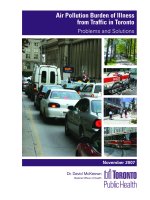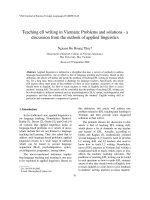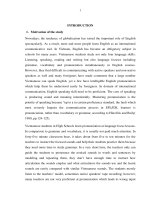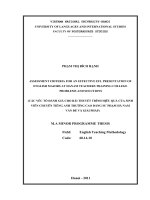Traffic problems and solutions d
Bạn đang xem bản rút gọn của tài liệu. Xem và tải ngay bản đầy đủ của tài liệu tại đây (716.94 KB, 13 trang )
<span class="text_page_counter">Trang 2</span><div class="page_container" data-page="2">
<b>GROUP DISCUSSIONENGLISH 4</b>
<b>Topic: Traffic problems and sollutions</b><b>Group: 4Class: 231_ENTH1411_36Lecturer: Ms. Pham Minh Hong</b>
<b>Group preparation assessment: ………</b>
<b>Presentation assessment: List of students (in the order of presenting)</b> 7 Ngô Quốc Nguyên 8 Nguyễn Lê Thảo Nguyên
9 Nguyễn Khánh Linh
</div><span class="text_page_counter">Trang 3</span><div class="page_container" data-page="3"><b> 1.Greeting:</b>
Good morning, we are group 4. Today, we are so glad to being here to present our topic is Traffic problems and solutions
<b> 2.Introducing the group’s members:</b>
We all have nine members: 1. Ngo Quoc Nguyen - Leader 2. Dang Thi Hang Nga - Secretary 3. Nguyen Khanh Linh 4. Nguyen Huyen Ly 5. Tran Ngoc Khanh Linh 6. Lai Thuy Nga 7. Nguyen Le Thao Nguyen 8. Quang Bao Ngoc 9. Quang Thi Bich Ngoc
<b> 3.Introducing the group’s topic:</b>
Students of the Thuong Mai University are no strangers to the crowded scenes at the school gate, at the intersection of Xuan Thuy, along Lang Street, Nguyen Chi Thanh Street, or even further at the bustling Nga Tu So junction. Traffic congestion, accidents, and countless other transportation issues await us every time we step outside.
Therefore, today our group has brought to this class a hot, informative, and urgent topic, which is traffic problems and solutions for them.
</div><span class="text_page_counter">Trang 4</span><div class="page_container" data-page="4">Name of the topic we will discuss about is “Traffic problems and solutions.”
<b> 4.Outlining the presentation:</b>
Our presentation includes four parts. The first is about traffic problems in today's life. The second part looks at the causes of traffic problems. The third part discusses the consequences of traffic problems. The final section deals with some solutions to traffic problems
<b>II.BODY DEVELOPMENT</b>
<b> 1.Traffic problems in today's life a) In the world :</b>
<b> </b>Nowaday traffic problems are one of the most serious problems in many countries in the <b>, </b>
world, especially traffic jams have become an integral part of cities around the globe. According to the TomTom Traffic Index which tracks congestion in major cities around the world, New York is ranked as the city with the worst congestion in America. Drivers can travel only 19 km per hour during peak times. In London, buses, trucks, taxis, and cars are often stuck in traffic in the morning making it difficult to get to school or work. It is estimated that motorists in London lose an average of 2,430 pounds ( 3,360 dollars) annually due to traffic congestion. It is in Europe, and in Asia, according to the list of 15 cities with the worst traffic jams during rush hour in 2016, Bangkok – the capital of Thailand ranks first. Particularly Thais spent an average of 61 hours in traffic jams, compared to 42 hours in Russia and the United States. In addition, the state of Karnataka – is known as India’s Silicon Valley where many people have given up driving later altogether or choose longer routes to get around to avoid getting stuck. According to estimates from the Bengaluru Development Authority in Karnataka in 2018, 11.8 million citizens of the city are deprived of 600 million hours a year due to traffic jams.
<b> b) In VietNam:</b>
Traffic problems in Vietnam are a significant and pervasive issue that affects the daily lives of its residents. With a rapidly increasing population, urbanization, and a surge in vehicle ownership, the existing transportation infrastructure in the country is struggling to keep up with the growing demand. According to statistics in April this year, the country currently has more than 14 million motorbikes while the transport infrastructure in Vietnam has only reached 10 to 15 percent. One particular example of traffic problems can be observed in Ho Chi Minh City, the largest metropolis in Vietnam. The city experiences severe congestion during peak hours, with vehicles moving at a snail's pace and commuters spending hours stuck in traffic. Motorbikes, the most common mode of transportation, often contribute to traffic woes by weaving through traffic, disregarding traffic signals, and creating a sense of disorder on the roads. The lack of proper traffic management and inadequate parking facilities further exacerbate the situation. Another
</div><span class="text_page_counter">Trang 5</span><div class="page_container" data-page="5">example can be seen in Hanoi, the capital of Vietnam, where traffic jams are a daily occurrence, especially in the city center. During rush hours, roads become highly congested, causing frustration and delays for commuters. The chaotic nature of traffic in Vietnam is further intensified by the lack of well-defined pedestrian infrastructure, making it challenging for pedestrians to safely navigate the streets. Additionally, the insufficient enforcement of traffic laws allows for reckless driving behaviors, such as speeding and running red lights, further contributing to congestion and making the roads less safe for everyone. The government has taken steps to address these traffic problems, including the introduction of stricter traffic laws, investments in infrastructure improvements, and the promotion of public transportation. However, the reality of traffic problems in Vietnam remains a persistent challenge that requires ongoing attention and innovative solutions to ensure smooth and efficient mobility for its residents.
<b> 2.Causes of traffic problems a. Objective reasons.</b>
The traffic sign system in many places is not properly distributed: The issue of traffic signs is a very important issue for people to ensure, firstly, safety, secondly, social order and urban traffic order. However, currently, there are many signs located in incorrect locations or hidden for a long time without being discovered or known without being replaced.
Infrastructure issues are also one of the issues affecting traffic:
- Roads are seriously degraded: rough roads, many "potholes". Therefore, there is a potential risk of causing traffic safety for road users
- Traffic problems can also be caused by inadequate infrastructure, such as poorly maintained roads or bridges. Road width that is too narrow or doesn’t comply with standards, sharp curves, steep downhill and uphill, pavement surface damage, and non-illuminated roads are some of the factors that cause traffic accidents. Besides, the highway and road network are incapable of meeting the requirement of increasing number of vehicles
Traffic infrastructures will be overburdened by the immense volume of vehicles. Maintenance cannot keep up with the speed of deterioration due to constant traffic. In Hanoi, Vietnam’s capital, there are numerous repair sites that cannot finish their operation in time because roads break down faster than they can be fixed.
Weather factors such as Fog, storms, high winds, etc. are also one of the objective causes of traffic accidents.Weather may affect visibility and cause travel delays and there is a high risk of accidents due to the driver's obstructed vision, not being able to clearly see moving vehicles and other obstacles. In addition, many streets in big cities like Hanoi are usually flooded when it has heavy rain making it difficult to move.
<b> b. Subjective reasons</b>
Traffic participants are not highly aware of the serious consequences of traffic accidents and traffic participants' awareness of obeying the law is low: only obey the law when you see traffic police presence. If there are any loopholes, you are ready to run red lights, speed, swerve, swing, not wear helmets, etc. Many vehicles on the road never use them to turn signals, signals, horns, etc. Especially the situation of traffic participants with alcohol concentrations exceeding the prescribed level, affecting the alertness of the driver and causing accidents. Accidents are mostly
</div><span class="text_page_counter">Trang 6</span><div class="page_container" data-page="6">caused by the unconsciousness of traffic participants and cause a lot of damage to people and property.
Using vehicles that do not comply with regulations or do not ensure safety when participating in traffic (such as arbitrarily changing the structure of the vehicle).
Vehicle drivers violating lanes, speeding violations, vehicle drivers using stimulants, ... Besides, the subjective cause of particularly serious accidents is that traffic participants drive continuously for many hours, so they are tired, fall asleep, encroach on lanes, encroach on the road, etc. When driving, they often Act instinctively, trust your driving experience and let your guard down.
<b> 3.Consequences of traffic problems</b>
Millions of people deal with traffic congestion on a daily basis. The roadways leading into and out of most major cities can become gridlocked due to an accident, road construction or simply a high number of cars on the road. Traffic congestion can have a number of effects on drivers, the environment, health and the economy. Fortunately, not all of the effects are negative.
<b> a)Health Impact of Traffic Jam</b>
Traffic congestion is a significant issue in urban areas. Traffic noise and traffic-related air pollutants co-exist in the traffic environment. Polluted air from road transport vehicles contributes significantly to air quality problems through vehicle emissions, which have various harmful impacts on public health.
Traffic and its allied effects can have various adverse health consequences. There is evidence which has confirmed that exposure to traffic noise significantly increases the risk for heart-related diseases, such as high blood pressure, heart attacks, etc. Also, traffic noise can induce adverse effects on the nervous system, leading to the increasing levels of anxiety, irritation, and sleeplessness.
<b> b)Pollution</b>
One of the most harmful effects of traffic congestion is its impact on the environment. Despite the growing number of hybrid vehicles on the road, cars stopped in traffic still produce a large volume of harmful carbon emissions. Besides contributing to global warming, these emissions can cause more short-term and localized problems, such as smog and increased respiratory problems in a community due to poor air quality.
<b>c)Fuel Consumption and Pollution</b>
The stopping and starting in traffic jams burns fuel at a higher rate than the smooth rate of travel on the open highway. This increase in fuel consumption costs commuters additional money for fuel and it also contributes to the amount of emissions released by the vehicles. These emissions create air pollution and are related to global warming.
<b>d)Economic Impact</b>
Drivers who encounter unexpected traffic may be late for work or other appointments, causing a loss in productivity for businesses and in the drivers' personal lives. Traffic delays may also slow down the shipping of cargo if delivery trucks can't remain on schedule due to a congested route. Drivers who know that traffic congestion is likely may decide to forgo an activity altogether, leading to less consumer spending and lower event attendance.
</div><span class="text_page_counter">Trang 7</span><div class="page_container" data-page="7">Drivers who become impatient may be more likely to drive aggressively or dangerously. This contributes to poor health for those affected by the stress and puts other drivers in danger. Road rage also increases the danger posed to emergency workers or construction crew members who are working on the congested road close to dangerous drivers.
<b> 4.Solutions to traffic problems</b>
A side effect of an ever-increasing world population, traffic congestion is a major problem in many cities worldwide. From encouraging carpooling to implementing intelligent traffic management systems, we discuss how to reduce traffic congestion in cities for improved movement efficiency.
Firstly, we need to promote the use of public transport. Public transportation systems like trains and buses can carry large amounts of people, significantly reducing the number of cars on the road. Cities can reduce traffic congestion by making public transport more accessible and attractive to commuters by lowering fares, increasing the frequency of vehicles, and improving the service quality.
Secondly, the government can implement road pricing. Road pricing charges drivers according to their use of roads, especially during peak hours. This can discourage drivers from using their cars during congested times in favor of other forms of transportation, reducing the number of vehicles on the road.
Thirdly, telecommuting or working from home can reduce traffic congestion in cities significantly. By working remotely, employees do not need to commute to their workplace, reducing the number of cars on the road. This method also brings benefits such as improved work-life balance, reduced commuting costs, and lower carbon emissions.
Fourthly, encourage carpooling is one of new measures. Commuters can cut down on the time they spend driving their cars or forgo the need for personal vehicles entirely. Cities can reduce traffic congestion by developing dedicated apps to facilities the process and offering incentives for using them.
Finally, introducing smart infrastructure like the Smart Radar, which uses sensors for vehicle and traffic tracking, can help improve traffic flow and reduce congestion. The data collected by this intelligent traffic management system provides drivers with real-time information on traffic updates and alternative routes to help them plan their journey more effectively.
From what our group has presented, we can see that the traffic problem is a difficult problem to avoid. It can come from different direct and indirect causes, but the biggest cause is still because people are still not aware of the seriousness of traffic jams, so in the process of participating in traffic, we have unintentionally made this situation more serious.
</div><span class="text_page_counter">Trang 8</span><div class="page_container" data-page="8">Not only Vietnam but anywhere in the world will have traffic problems. Traffic jams have brought many disadvantages and caused many impacts on our lives. As we mentioned, it can have negative effects on health, pollute the environment and sometimes lead to serious accidents. Although we do not have a solution to completely overcome this situation, we can take measures to prevent and limit it. Like the measures my group mentioned above, in addition to the impact of the government and advanced technology, each of us as individuals should also be aware of the seriousness of the traffic problem to be able to contribute. a small part in the work of preventing this bad situation.
And finally, hopefully our presentation has partly helped you understand more about traffic problems, and especially traffic jams. I'm pretty sure there will be a few people here who have also experienced traffic jams, so I hope that, after listening to our presentation, you will become part of the strength to contribute part to prevent this situation.
</div><span class="text_page_counter">Trang 9</span><div class="page_container" data-page="9"><b>MEETING MINUTE – GROUP: 4Minutes of the first meeting</b>
<b>Time: from 4 p.m to 5 p.m </b>on October 15, 2023
<b>Place: Google meetsMembers: enough 9 membersContents for discussing: </b>
- Assign the group leader and secretary again. - Assign task.
- Detailed reminders of each person's work. - Come up with ideas for filming and editing videos. - Briefly discuss the work of the next meeting.
<b> Conclusion: </b>
<b>-</b> Reasons, consequences, solutions: Write at least 1 page of word document. - Record live video with members present at corners around the campus.
- Saturday, October 21, meeting to summarize work: script, detailed video shooting plan.
<b>Duties for members: write content.</b>
Dang Thi Hang Nga Causes of traffic probles Lai Thuy Nga
Traffic problems in today's life Nguyen Khanh Linh
Nguyen Huyen Ly Consequences of traffic problems
Quang Thi Bich Ngoc Solutions to traffic problems Nguyen Le Thao Nguyen Come up with ideas for videos and shoot videos
Ngo Quoc Nguyen Create presentation content and assign tasks to team members
</div><span class="text_page_counter">Trang 10</span><div class="page_container" data-page="10">Quang Bao Ngoc Conclusion
<b>MEETING MINUTE – GROUP: 4</b>
<b>Minutes of the second meeting</b>
<b>Time: from 10:30 p.m to 11 p.m </b>on October 21, 2023
<b>Place: Google meetsMembers: enough 9 membersContents for discussing: </b>
- The whole group finalized the video filming schedule at 8:30 a.m. Wednesday - Assign script writing.
- The whole group chooses a filming location and discusses filming angles for each member. - The whole group comments on the content of the discussion that each member makes to edit and supplement.
- The device will be recorded during the filming session using Khanh Linh's phone.
<b>Conclusion: </b>
<b>-</b> Tuesday morning, the whole group met for the next session to write the script. - Gather at Building P during the filming session.
- The third meeting will take place on Tuesday at 9:30 am.
-There will be a fourth meeting after filming to summarize and comment on the discussion.
<b>Duties for members: </b>
All members review and edit their articles after being evaluated and given comments by the group.
<b>Head of the team</b>
(signature and name)
(signature and name)
<b>Head of the team</b>
(signature and name)
(signature and name)
</div>








